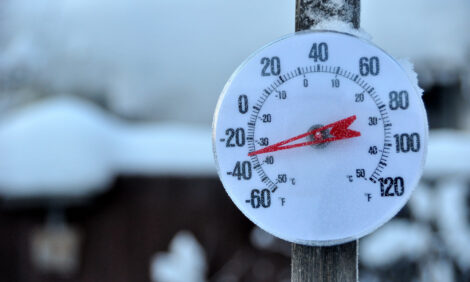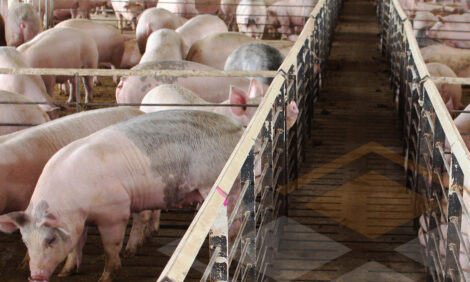



March 2002: Review of the U.S Hog Market
Our Monthly look at the trends in US Hog Market and what effect thes may have on future prices; Hog Prices Decline During March; Hog Imports From Canada Rise; Pork Exports Still Strong; Trade Awaits Hog & Pig Report; Futures Based Cash Price Forecasts - Written by James Mintert, Kansas State University.Hog Prices Decline During March
Barrow and gilt prices declined counterseasonally during March. Barrow and gilt prices in Iowa-S. Minnesota were 26% below a year ago in late March. The January-March barrow and gilt price average was near $54 (carcass weight), about 5% below a year ago. |
Similarly, estimates of USDA's pork cutout value also declined sharply, averaging 7% below a year ago during the first quarter.
 |
Pork production during January-March was up less than 1% from a year ago, but the percentage increases showed signs of rising as the quarter progressed. The pork production increase was driven primarily by hog weights averaging above last year since hog slaughter was actually down less than 1% compared to 2001.
 |
Canadian Hog Inventories Growing
Statistics Canada indicates that, unlike the U.S., the Canadian sow herd is growing rapidly. According to the most recent Canadian data, fourth quarter 2001 sow farrowings were up nearly 9% compared to a year earlier and Canadian producers estimated that farrowings during the first quarter would increase 7.7% and second quarter farrowings would increase nearly 8%. When combined with U.S. estimates of actual farrowings and farrowing intentions (from USDA's December Hogs and Pigs report), it implies that North American slaughter this year will rise more than previously forecast.The combination of virtually no change in U.S. farrowings last fall and the large increase in Canadian farrowings means that combined spring quarter slaughter will rise about 2 to 3% above last year's. Combining estimates of first quarter Canadian and U.S. farrowings implies that slaughter this summer could rise about 5% above summer 2001's. And U.S.-Canada slaughter this fall could rise 3 to 4% above the previous year.
The fall quarter slaughter estimate is the most troubling. The reason is a slaughter increase of this magnitude could tax North American slaughter capacity. During the fall of 1998 U.S. hog prices collapsed as available hog supplies swamped U.S. slaughter capacity. Combined U.S. and Canadian hog slaughter that fall (federally inspected) totaled 33.14 million head. During fall 2001, combined U.S. and Canadian hog slaughter reached 33.36 million head and a 3% increase in slaughter supplies would push fourth quarter slaughter up over 34.3 million head, about 1.2 million head more than in 1998 and a million head more than last fall.
The primary increase in hog slaughter capacity since 1998 took place on the Canadian side of the border when Maple Leaf Foods' Brandon, Manitoba plant came on line. This plant is currently only operating one shift per day, but could expand to two shifts, if market conditions warrant it. However, it is difficult to export slaughter hogs from the U.S. to Canada because of animal health issues mostly related to pseudorabies in the U.S. Thus, it's possible that available slaughter capacity in Canada will be underutilized this fall, despite a shortage of shackle space in the U.S. This situations needs to be addressed in U.S.-Canada trade negotiations this spring and summer before it becomes a problem this fall.
Hog Imports From Canada Rise
Total hog imports from Canada during January rose 31% (134,060 head) compared to last year. Approximately 93% of the increase in hog imports was attributable to an increase in feeder pig imports. So, it appears that the majority of the increase in Canada's pig crop is being exported to the U.S. for feeding in the Northern Corn Belt.Pork Exports Still Strong
Pork exports were up again during January. Total pork exports rose 11% above the previous year during January and the January increase followed an 11% increase during 2001's fourth quarter. For the year, pork exports during 2001 rose 19% above the previous year.January's pork export increase was driven primarily by strong exports to Japan. U.S. pork exports to Japan rose 13% during January. Exports to Canada, Mexico, and S. Korea were also strong during January. Pork exports seem to be benefiting from Japanese consumers' concerns about BSE and beef. So, it looks like pork exports to Japan will remain strong over the next few months. Moreover, Japan's Safeguard tariff is scheduled to go off at the end of March, which could provide an additional boost to U.S. pork exports.
Trade Awaits Hog & Pig Report
USDA's March Hogs and Pigs report is scheduled for release on Thursday, March 28, 2002, after this report went to press. Preliminary trade expectations are for a U.S. breeding herd near last year's level, but market hog and total hog herd inventories 1 to 2% larger than in 2001.Futures Based Cash Price Forecasts
Futures prices, adjusted for basis expectations, are a source of continuously updated cash price forecasts. As an example, Western Corn Belt 51-52% lean barrow and gilt price forecasts based upon futures prices at the time of this writing (3/22/02) settlement prices) adjusted for basis expectations are included in a graphical format. Basis forecasts are based upon the most recent three-year average basis for 51-52% lean barrows and gilts. To provide some indication of the amount of risk present, forecasts based upon the most positive and negative basis of the last three years are also included. Weekly updates (in graphical form) of these price forecasts are also available on the K-State Livestock & Meat Marketing Web Site (www.agecon.ksu.edu/livestock) in the weekly electronic publication entitled Hog Price & Supply Graphs. |
Weekly updates (in graphical form) of these price forecasts are also available on the K-State Livestock & Meat Marketing Web Site (www.agecon.ksu.edu/livestock) in the weekly electronic publication entitled Hog Price & Supply Graphs.
Information provided by KSU Livestock report. For more information visit the KSU Livestock website.
Reproduced with permission.






